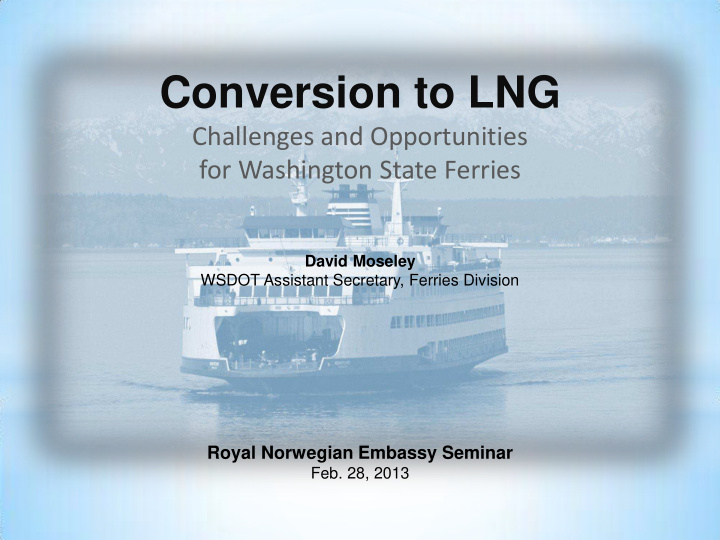



Conversion to LNG Challenges and Opportunities for Washington State Ferries David Moseley WSDOT Assistant Secretary, Ferries Division Royal Norwegian Embassy Seminar Feb. 28, 2013
• More than 22 million riders per year • 10 million vehicles carried per year • Fleet of 23 ferries that carry 34-202 cars and 750-2,500 passengers • 20 terminals on 10 routes • 450 daily departures • 1,800 employees 2
• Largest system in the United States • Fourth largest carrier of passengers in the world • Largest carrier of vehicles in the world 3
Route Commuter Tourist Island link Commercial Anacortes/Sidney Anacortes/San Juan Islands Port Townsend/Coupeville Mukilteo/Clinton Edmonds/Kingston Seattle/Bainbridge Island Seattle/Bremerton Fauntleroy/Vashon/Southworth Point Defiance/Tahlequah 4
• WSF burns more than 17 million gallons of ultra-low sulfur diesel each year. • Fuel is the fastest growing operating expense – more than 29% of 2011-2013 budget compared to 12% in 2000-2001. • WSF’s 2013 fuel budget is $74.3 million – $58.7 million more than 13 years ago. 5
WSF has embarked on several fuel initiatives: • Slowing as sailing schedules allow • Operating on fewer engines • Exploring ways of holding vessels in the dock with less power • Fuel hedging • Hyak hybrid pilot project • Liquefied natural gas 6
• WSF is exploring an option to use LNG as a source of fuel for propulsion. • This is an opportunity to reduce fuel costs and decrease emissions. • Conceptual approval has been received from the U.S. Coast Guard to retrofit propulsion systems with new engines on all six Issaquah Class ferries. • U.S. Coast Guard ruled LNG not considered a major conversion. 7
3-year Avg. Annual Usual Route Vessel Diesel Gallons Issaquah Fauntleroy - Vashon – Southworth 601,000 Kitsap Seattle - Bremerton 755,000 Kittitas Mukilteo - Clinton 450,000 Cathlamet Mukilteo - Clinton 514,000 764,000 Chelan Anacortes - Sidney Sealth Anacortes – Friday Harbor 633,000 3,717,000 Total average annual diesel gallons 85% of diesel gallons converted* 3,159,000 Projected Annual savings $6.4 million (approx. $2/gal. of diesel replaced) Projected LNG gallons 5,370,000 * Approximately 15% diesel remaining for ship service and emergency generators 8
9
• Maintaining system safety with • Upper deck tank location reduces available space for passengers on the use of a cryogenic fluids as classes other than Issaquah fuel. Handling and storage of LNG requires: • Fuel lines run in existing casing in a Double-walled piping, double- double wall configuration; bunkering walled tanks and cold box for from main deck requires pumping leak containment LNG from truck to upper deck Ventilation and gas supply • Installation of new gas engines: monitoring Gas engines are larger and Nitrogen purge system for gas heavier supply and lines Engine performance – critical for Dry chemical fire extinguishing maneuvering, crash stop, system acceleration – is lower for a gas • Dependable access to reasonably engine than a diesel engine priced LNG sources is critical to successful conversion 10
• Ease of Installation: no major structural • Bunkering requires a dedicated modifications cryogenic pump • Leaks naturally dissipate into the • Glycol vaporization system run atmosphere from the engine room • Maintenance • Tanks separated from the engine Easy access to all components room crew Flexible arrangement of piping and • Pumping LNG adds heat to the vent systems fluid reducing the fueling rate • Area is isolated from passenger space on Issaquah class 11
Two tanks: 24,440 gallons each. Total: 48,880 gallons 12
• Initial capital investment – $84.5 million • LNG availability • Crew training • Crew acceptance • Improve internal/external communication • Public perception • Lack of U.S. Coast Guard regulation for vessel and terminal LNG operations (i.e. training, credentials, potential refueling). Unknowns could significantly affect operating budgets. 13
• Complete Safety and security assessments and plans • Obtain U.S. Coast Guard approval for detail design • Complete final design • Obtain Funding for retrofit construction • Train crews 14
For more information about the WSDOT Ferries Division, please contact: David Moseley Assistant Secretary, WSDOT Ferries Division 206-515-3401 or MoseleD@wsdot.wa.gov 15
Recommend
More recommend